Get Started: Indoor Gardening Activities for Kids
Learn how to re-grow food from scraps!
Simple Indoor Gardening Activities for Kids
It’s almost spring, which is a great time to explore plant and garden activities with children. There are many fun options for families even if you do not have an established garden or an outdoor growing space. Last season, we shared a great indoor seed germination project. This post introduces two family-friendly activities that require very few materials or growing experience, use left-over “kitchen scraps” and easy to find vegetables, and provide a hands-on growing experience for children of all ages.
Regrowing Food from Vegetable Scraps
This project can be done with a variety of common vegetable scraps, such as green onions, romaine lettuce, or celery (bottom 2-3”). You may also use the “tops” (top 1-1.5”) of root vegetables like carrots and beets with the same technique.
MATERIALS:
Vegetable scraps of choice
Water
Shallow glass or dish (clear if possible)
Sunny window
(Optional) potting soil and container
STEPS:
Keep the bottom 2-3” of celery, lettuce or green onion. If using root vegetables, keep the top 1-1.5” of the carrot, beet, radish, etc.
Place the vegetable ends in a shallow dish or glass and cover with a small amount of water, making sure to only cover about ½” of the base.
Place the dish on a sunny windowsill.
Replace with fresh water daily or when you notice the water in the dish is getting murky or brown. This is a great task for kids.
Watch the plant grow! New growth will emerge from the center of the scraps. Older kids may enjoy measuring and tracking the growth of the new plant and watching for the emergence of roots in the water. The plants are usually fast growing and fun to watch!
After ~2 weeks, you should see new roots growing in the water. At this point you can either cut off and eat the new leafy growth, or you can plant the base of the vegetable in a container with potting soil and allow it to grow even larger. Root vegetables like carrots will need to be transplanted into soil to fully regenerate.
If you re-pot the plant, continue to water it near the soil, keeping it moist but not soggy. When the plant is your desired size, harvest and enjoy!
Sweet Potato Houseplant
Sweet potatoes are vining plants with heart-shaped leaves that make a beautiful and easy to set-up houseplant. This project is an excellent demonstration of plant growth for children, and has the option of extending to an outdoor project, if desired.
MATERIALS:
Whole Sweet potato (*may have better luck with organic varieties)
Jam or Mason jar
Water
Toothpicks
Sunny window
(Optional) potting soil and container
STEPS:
Stick 3 - 4 toothpicks into the midpoint of the raw sweet potato, about half way down the length. These will rest on the lip of the jar to suspend the potato above the water.
Fill the jar with water and place the potato into the opening of the jar with the “pointed” end facing down and submerged into the top inch of water.
Place the potato jar on a warm and sunny windowsill, and monitor the water level to keep the bottom inch of the potato submerged.
After 2-4 weeks, you should be able to see new root and leafy growth. This is a great chance to talk to children about the parts of the plant and the role of roots in “drinking” water to keep the plant alive. Ask children to observe changes in the plant; older kids might enjoy recording and measuring the new growth.
(Optional) When the roots grow long enough to reach the base of the jar, you may re-pot the potato in a container with potting soil and compost blend. The pot should be big enough to contain the roots without cutting or folding them. This will allow the plant to continue to grow, and you can continue to transplant into larger pots as a houseplant when the roots outgrow the container.
(Optional) You may also break off the new shoots from the top of the potato (make sure you get at least 4-6”) or plant them outdoors as “slips” if you want to obtain a harvest later. Children LOVE digging for sweet potatoes! Sweet potato vines are sprawling and will need either space or a trellis to grow on.
Getting Stared: Seeding Spring Crops Indoors
Dig a little deeper into why, when, and how to start your seeds indoors before you plant them outside!
Why Start Seeds Indoors?
It is a great idea to plant seeds indoors for crops that tolerate transplanting into your garden as seedlings. Plants started indoors have better germination rates due to a stable environment and protection from pests, and vigorous seedlings can flower and be ready to harvest sooner. Plus, you’ll soon have beautiful baby plants to brighten up the last dreary days of winter!
What Seeds Can I Plant in Winter?
Not all plants like to be transplanted as seedlings, but many popular crops get a good head start indoors. Seed packages will indicate if the seed can be started indoors or be sown directly outside. Many early crops, including broccoli, cauliflower, kale, and lettuces, can all be started in February! Our farmers start the following spring crops in our greenhouse: kale, collards, mustard, and Swiss chard.
Other crops that will transplant into your garden early and tolerate light frosts include: all brassicas (Broccoli, Brussels sprouts, Cauliflower, and Cabbage), and leafy greens such as Collards, Mustards, and all Lettuce varieties.
The right time to start seeds indoors depends on two main factors: 1) When they can be planted outside, and 2) How long they need to grow to the appropriate size. To figure this out, you need to know your region’s average last frost date. In Missouri, we are in zone 6B and this date is April 15th. This is the date that divides when you can transplant early crops (that tolerate light frost) from those that must be transplanted weeks after the last frost in warmer soil.
Many warm season vegetables and herbs can also be started early (February or March), and kept for longer indoors. By the end of February, our farmers will start tomatoes, peppers, eggplant, thyme, sage, and lavender seeds in our greenhouse. These seedlings need more time to be ready for transplant, so it helps to start them early.
Find your Planting Calendar
This can seem like a lot of information to manage! Getting some help from a good planting calendar helps you determine when to start your crops. Many agricultural extension services publish calendars for their region. Here in Missouri, Missouri University Extension maintains a guide on when to start seeds indoors and a planting calendar that details when transplants can be moved outdoors and seeds be sown directly outside.
DIY Seed Trays
Popular seed-starting containers that you can purchase at a nursery or home and garden store include: plastic, wooden, or fiber trays, small plastic or ceramic pots, biodegradable peat pots, and peat pellets. However, if you’re looking for upcycling options to save money and reuse materials, you have many options! Here are some fun DIY seed tray ideas: Eggshells and egg cartons, Takeout containers, milk cartons, toilet paper rolls, and newspaper pots.
Tips for Strong Seedlings
Germination medium
You may purchase or make your own germination mix, which must be fine-textured, loose and light weight, and drain quickly. It is best not to use regular planting soil or fertilizer at this early stage.
The primary components of these mixes are: Perlite, Peat, and Vermiculite
Enough light
Seeds do not need light to germinate, but once they’ve sprouted they will definitely need plenty! Seeds often do very well under “grow lights,” but if this is not something you can do, make sure to place them in a south-facing window to maximize how much sunlight they get each day.
Air circulation
Initially, many growers cover their seed trays with a clear plastic dome. This creates a mini-greenhouse effect, trapping humidity and warmth to promote germination. Once your seeds have sprouted, however, it’s a good idea to remove the dome regularly to get fresh air to the seedlings.
Air flow and a breeze on your growing seedlings will help strengthen their stems. Many gardeners set up fans indoors to circulate air, but you can also replicate this effect by regularly running your hands gently over the seedlings to simulate air movement.
Watering
Seeds and seedlings do best when kept evenly moist. Too much water will promote mould growth in your germination mix or even drown your roots. Check daily to make sure that the growing media is damp rather than dry or soaking, and lightly water when needed.
For more details, check out MU Extension’s guide to starting plants indoors from seed.
Brassica Pests: Solutions (Part 2 of 2)
Once you have identified which pest is attacking your brassica crops, then you can work towards managing the problem. In this case, most of the treatments are very similar for all 3 kinds of caterpillars.
By Rebecca Halcomb, Leadership in Urban Agriculture Internship, Fall II 2020
Once you have identified which pest is attacking your brassica crops, then you can work towards managing the problem. In this case, most of the treatments are very similar for all 3 kinds of caterpillars. There are a few specific solutions, but I’ll note those below:
Row Covers: Cover brassica crops with floating row cover or screen cover from when you plant to when you harvest to keep the butterflies and moths off. You should still regularly inspect though. You can also use pantyhose on cabbage heads, and those will grow with the plant and let enough air, sunlight, and moisture in.
Hand-picking: It can be time-consuming and they can be easy to miss, especially the 2 green species. They like to hide on the underside of the leaves, and blend in with the leaf veins. It’s actually much easier to see their dark green frass (poop) than it is to see them. You can drown them in soapy water once you pick them off.
Use Predators: Hang birdhouses in or near the garden or let the chickens into the garden temporarily once the plants are hardy enough, and they will eat the caterpillars for you.
Plant Tolerant Varieties: Some examples of green cabbage varieties that are a more resistant are Green Winter, Savoy, and Savoy Chieftain. You can also try planting red-leafed varieties of cabbage and kohlrabi, which are less desirable because of lack of camouflage for the 2 green caterpillars.
Attract Beneficial Insects: You can either buy them directly, or plant a good selection of flowers and flowering herbs around your brassicas to attract the beneficial insects that will prey on your pests. Some plants to use for this would be parsley, dill, fennel, coriander, and sweet alyssum. (Be careful if cross-striped cabbageworms are your culprit, because they also destroy parsley.) These flowers will attract parasitic wasps, paper wasps, yellow jackets, and shield bugs. Parasitic wasps will lay their white cocoons on the caterpillars’ backs. Leave the cocoons alone to kill off your pest, and then you’ll have a new generation of parasitic wasps for later waves of pests. If you don’t want to rely on your flowers to attract them, you can purchase trichogramma wasps, and release them to destroy the pests’ eggs.
Use Companion Planting: Interplant companion plants among your brassicas that repel the butterflies/moths, like aromatic herbs such as lemon balm, sage, oregano, borage, hyssop, dill, and rosemary, or high blossom flowers like tall marigolds or calendula.
Use Trap Crops: For Loopers, plant celery or amaranth. For Cabbage Worms, plant nasturtiums or mustard. The butterflies/moths will lay their eggs on those crops first, and then once you see the pests, you can dispose of the trap crop to get rid of them.
Frequent Harvesting: For the cut and come again crops, such as Kale and Collard Greens, harvest the leaves more frequently to interrupt the pest life cycle.
Pheromones: Use pheromone traps to monitor and control their populations.
Biological Pesticides: Spray with BT (Bacillus thuringiensis). It’s a natural bacterium that kills caterpillars and worms. BTK sprays in particular do not harm honey bees or birds and are safe to use around pets and children. One source said to spray for Loopers early in the season as a preventative, and then use again for later waves. For cabbage worms, it said to spray every 2 weeks until they get under control. Another source said that one treatment in late summer approximately 2 weeks before harvest can greatly improve your crop quality. You’ll have to reapply after rain though.
Diatomaceous Earth (DE): DE is a very fine powder that when sprinkled can cut up any soft-bodied insect that comes into contact with it. This also has to be reapplied after rain.
Insecticidal Soap: Spray with Organic Insecticidal soap, but this also has to be reapplied after the rain.
Other Repellent Sprays: For Loopers, you can spray the crops with liquefied and strained cabbage loopers or hot pepper spray.
Seasonal Clean Up: For the cabbage worms, do a thorough fall clean-up of old plants and debris, since the butterflies like to overwinter there. (The white cabbage butterfly usually shows up early in the spring because they overwinter instead of migrate.)
Use Decoys: This method is a little experimental, but supposedly the Cabbage Butterflies are territorial and don’t like to lay their eggs if they think another female has already claimed your plants. So you can make white butterfly-shaped decoys out of plastic or another durable material, and put them by your garden plants. Make them 2 inches wide, and with 2 black spots on the upper wing. I think I’m going to repurpose some milk cartons and give it a try. Here’s the link to a template: http://goodseedco.net/blog/posts/cabbage-butterfly-decoy
RESOURCES
This was a very beneficial website that gave some practical tips on controlling cabbage loopers: https://www.planetnatural.com/pest-problem-solver/garden-pests/cabbage-looper-control/
Missouri Botanical Garden has info and tips:
Imported cabbageworm: https://www.missouribotanicalgarden.org/gardens-gardening/your-garden/help-for-the-home-gardener/advice-tips-resources/pests-and-problems/insects/caterpillars/imported-cabbageworm.aspx
Other Sources:
https://savvygardening.com/guide-to-vegetable-garden-pests/
Brassica Pests: Identification (Part 1 of 2)
Learn to identify the pests that damage brassica crops of collard greens, kale, broccoli, and cabbage.
By Rebecca Halcomb, Leadership in Urban Agriculture Internship, Fall II 2020
I had a lot of pest issues this year, but the ones that did the most damage were the pests that took out my brassica crops of collard greens, kale, broccoli, and cabbage.
I had hand-removed a few caterpillars, but less than a week later, this was what I found when I walked out to my garden on August 14th:
These had been the largest most beautiful collard greens I’d ever grown, and were now covered in caterpillars I didn’t recognize:
When I came to intern at Urban Harvest STL, I noticed one of the same pests I had encountered on my brassicas, and learned it was called a cabbage looper. I originally thought it was just the cabbage looper in various phases that I was dealing with in my garden, but when I started researching and looked back at my garden pictures, I noticed that the caterpillars on my collard greens and kale were different from the caterpillars on my broccoli, so I was dealing with multiple pests. I decided to research both pests I had issues with, and then I also ended up finding info on another cabbageworm called the imported cabbageworm. That caterpillar looked very similar to the cabbage looper, but the butterfly was different, so I wanted to address those as well.
First let’s look at how to identify all 3 brassica-eating culprits.
Cabbage Looper ID
Here’s a picture of the cabbage looper moth to look out for.
It will lay eggs that look like this.
As a caterpillar, it will look like this.
Imported Cabbage Worm ID
The imported cabbage white butterfly to watch out for, that produces the green imported cabbage worm, looks very similar to the cabbage looper caterpillar.
Their eggs are also tiny and white, but more cone-shaped.
This is what the green cabbage worm looks like. It’s slightly fatter, doesn’t make the distinctive loop with its back when it crawls, and has a faint yellow stripe down the back.
Cross-Striped Cabbageworm ID
It took me awhile to find the name for the striped caterpillar that skeletonized my collards so badly, but I finally found my worst culprit: the cross-striped cabbageworm.
Here are some pictures of the moth to look out for, the eggs they will lay, and a better close up of the caterpillar:
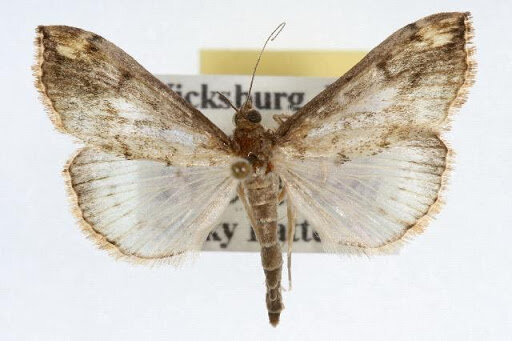
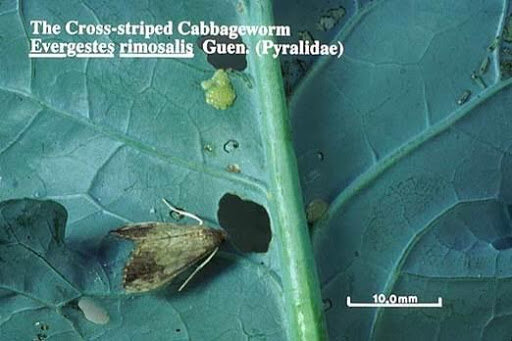
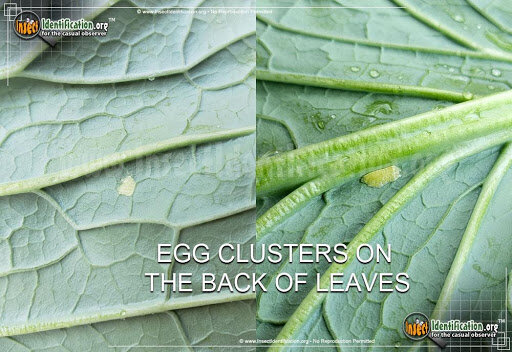
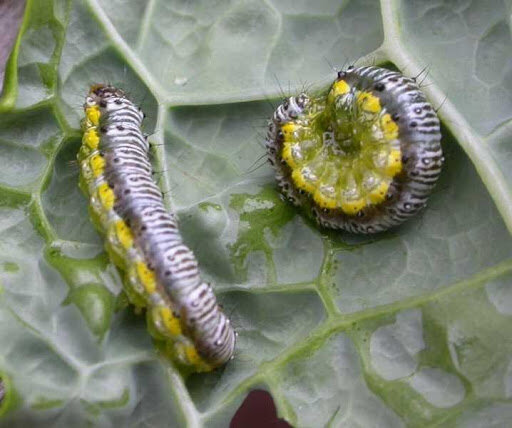
The moral of this is that pest ID can sometimes be tricky, but it’s definitely worth it so you know what you’re dealing with, and the best way to manage the pest so that you can harvest as much high quality crop as possible. In Part 2, we’ll examine how to thwart our brassica foes.
Resources
University Extension websites have compiled a lot of helpful info on garden pests:
University of Minnesota Extension has pictures of the cabbage looper eggs, which are very tiny white round dots, about the size of a pinhead. There are also pictures of the dark green pellets that they excrete: https://www.vegedge.umn.edu/pest-profiles/pests/cabbage-looper
UMass and UConn Extensions have some good info on the Cross-Striped Cabbage Worm: https://ag.umass.edu/vegetable/fact-sheets/cross-striped-cabbage-worm
http://ipm.uconn.edu/documents/raw2/html/579.php?display=print
Non-Extension Resources:
This website has pictures of the various Cabbage Looper stages, their defining characteristics for accurate ID, as well as a full list of the plants they feed on, and their egg laying schedule: http://www.idtools.org/id/citrus/pests/factsheet.php?name=Cabbage+looper
This website notes the difference between the Cabbage looper and Imported cabbageworms: https://www.growveg.com/pests/us-and-canada/cabbage-worm-cabbageworm-cabbage-looper/
Some helpful info that compare the 2 cabbageworms: https://theberkshireedge.com/natures-turn-unwelcome-cabbage-white-butterflies-and-dreaded-cross-striped-cabbage-moths/
Preparing Your Soil
Learn what makes up healthy soil and the steps you need to take to prepare for planting. Urban farmer Megan and director of urban agriculture Drew walk you through the essentials! Filmed on location at the FOOD ROOF Farm.
Learn what makes up healthy soil and the steps you need to take to prepare for planting. Urban farmer Megan and director of urban agriculture Drew walk you through the essentials! Filmed on location at the FOOD ROOF Farm.
Get Started: DIY Organic Fertilizers
The most important factor for healthy plant growth is healthy soil. As mentioned in Part 1, the key to building healthy soil is the regular addition of soil amendments like compost. If you are looking to replenish specific nutrients or to grow heavy feeders like tomatoes, you can make your own organic plant food at home. You need only apply small quantities when plants need it, rather than large amounts over the whole garden. Remember: LESS IS MORE when it comes to fertilizer. Read on for some low-cost or no-cost options for making your own gentle organic fertilizers at home.
The most important factor for healthy plant growth is healthy soil. As mentioned in Part 1, the key to building healthy soil is the regular addition of soil amendments like compost. If you are looking to replenish specific nutrients or to grow heavy feeders like tomatoes, you can make your own organic plant food at home. You need only apply small quantities when plants need it, rather than large amounts over the whole garden. Remember: LESS IS MORE when it comes to fertilizer.
Here are some low-cost or no-cost options for making your own gentle organic fertilizers at home.
Comfrey Liquid Fertilizer
Harvest a large bag of comfrey leaves. Be sure to wear gloves, as leaves can cause irritation.
Fill a large bucket or container with crushed leaves and weigh them down. Cover with a lid to contain the smell.
Leave for 2 weeks. The leaves will produce a dark concentrated liquid – drain this into a separate container and toss used leaves in the compost pile.
Mix 1 part comfrey concentrate with 15 parts rainwater (1:15) in a watering can and apply it to the soil at the base of your plants.
Nettle Tea
Stinging nettles are common plants (even considered weeds!) that can be steeped to create a liquid nitrogen fertilizer.
Using gloves (plants will sting), cut leaves and stems at the base (do not include the roots) and fold, chop, or crush them into a bucket.
Fill the bucket with rainwater and cover and place in a warm sunny spot.
Check every 2 days to stir the tea. Foam on the top is normal.
The tea will take 2 weeks in a warm location, and up to 3 in a cool or shady spot. You can strain the tea into a new container through a cheesecloth or scoop the plant parts out of the liquid and add to the compost pile.
To use, mix 1 part nettle tea with 10 parts water (1:10) poured at the base of plants
(Note: You will still need to use compost to get the most out of this fertilizer. It is not meant for beans, peas, onions, potatoes and root vegetables).
Quick Fix Fertilizer Recipe:
In a 1 gallon container, add
1 tsp baking powder
1 tsp ammonia (quick nitrogen),
3 tsp instant iced tea (tannic acid),
3 tsp blackstrap molasses (feeds soil bacteria)
3 tbsp of 3% hydrogen peroxide (oxidizer)
1/4 C crushed bone scraps (phosphorus—fish bones provide potassium)
1 crushed eggshell (calcium & potassium)
1/2 dried banana peel (potassium)
Fill the jug the rest of the way with water (rainwater is best)
Replace cap and allow the jug to sit in the sun for about 1 hour to warm.
Water your plants with this mixture at full strength.
Kitchen Waste
These are some common outputs from a kitchen that many home gardeners have adapted to feed their plants. There are many “myths” about these materials, however, they may be used as below:
Spent Coffee Grounds: Often applied to acidic-soil loving plants like berries or azaleas. Grounds are high in nitrogen, but there is debate among growers if they are beneficial when directly applied to vegetable beds. Due to their residual caffeine and high nitrogen content, they are probably most effective for adding to a compost pile with a lot of woody/brown materials to create a balanced compost.
Eggshell: High in calcium, egg shells can balance oil acidity and assist with nutrient uptake. Egg shells decompose very slowly, however; therefore, they should be pulverized with a mixer, grinder, or mortar and pestle before you add them to soil or compost. You can steep dried eggshells in water for a few days and use them on both indoor and outdoor plants for a calcium boost.
FOOD FOR THOUGHT
Can you skip fertilizer altogether? This home gardener explains why he never uses fertilizer and gets results without it.
REFERENCES
Vegetable Garden Fertilizer 101
Feeding Your Plants for Free - How to Make Fertilizer for Your Vegetable Garden
